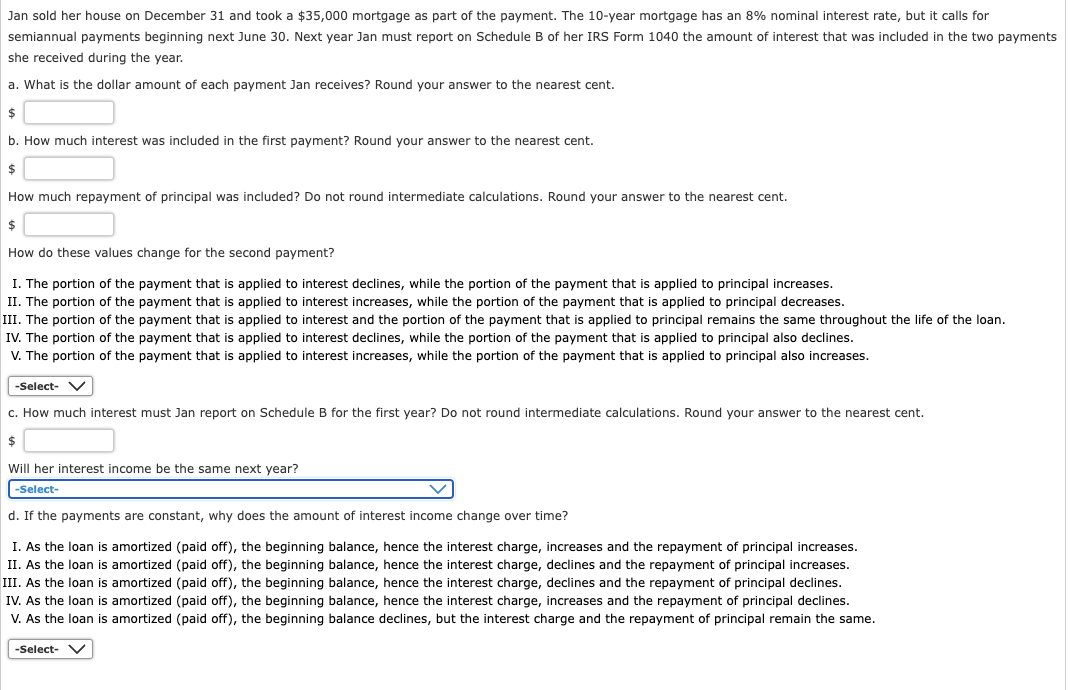Answered step by step
Verified Expert Solution
Question
1 Approved Answer
Jan sold her house on December 31 and took a $35,000 mortgage as part of the payment. The 10 -year mortgage has an 8% nominal
 Jan sold her house on December 31 and took a $35,000 mortgage as part of the payment. The 10 -year mortgage has an 8% nominal interest rate, but it calls for semiannual payments beginning next June 30. Next year Jan must report on Schedule B of her IRS Form 1040 the amount of interest that was included in the two paymen she received during the year. a. What is the dollar amount of each payment Jan receives? Round your answer to the nearest cent. $ b. How much interest was included in the first payment? Round your answer to the nearest cent. $ How much repayment of principal was included? Do not round intermediate calculations. Round your answer to the nearest cent. $ How do these values change for the second payment? I. The portion of the payment that is applied to interest declines, while the portion of the payment that is applied to principal increases. II. The portion of the payment that is applied to interest increases, while the portion of the payment that is applied to principal decreases. III. The portion of the payment that is applied to interest and the portion of the payment that is applied to principal remains the same throughout the life of the loan. IV. The portion of the payment that is applied to interest declines, while the portion of the payment that is applied to principal also declines. V. The portion of the payment that is applied to interest increases, while the portion of the payment that is applied to principal also increases. c. How much interest must Jan report on Schedule B for the first year? Do not round intermediate calculations. Round your answer to the nearest cent. $ Will her interest income be the same next year? d. If the payments are constant, why does the amount of interest income change over time? I. As the loan is amortized (paid off), the beginning balance, hence the interest charge, increases and the repayment of principal increases. II. As the loan is amortized (paid off), the beginning balance, hence the interest charge, declines and the repayment of principal increases. III. As the loan is amortized (paid off), the beginning balance, hence the interest charge, declines and the repayment of principal declines. IV. As the loan is amortized (paid off), the beginning balance, hence the interest charge, increases and the repayment of principal declines. V. As the loan is amortized (paid off), the beginning balance declines, but the interest charge and the repayment of principal remain the same
Jan sold her house on December 31 and took a $35,000 mortgage as part of the payment. The 10 -year mortgage has an 8% nominal interest rate, but it calls for semiannual payments beginning next June 30. Next year Jan must report on Schedule B of her IRS Form 1040 the amount of interest that was included in the two paymen she received during the year. a. What is the dollar amount of each payment Jan receives? Round your answer to the nearest cent. $ b. How much interest was included in the first payment? Round your answer to the nearest cent. $ How much repayment of principal was included? Do not round intermediate calculations. Round your answer to the nearest cent. $ How do these values change for the second payment? I. The portion of the payment that is applied to interest declines, while the portion of the payment that is applied to principal increases. II. The portion of the payment that is applied to interest increases, while the portion of the payment that is applied to principal decreases. III. The portion of the payment that is applied to interest and the portion of the payment that is applied to principal remains the same throughout the life of the loan. IV. The portion of the payment that is applied to interest declines, while the portion of the payment that is applied to principal also declines. V. The portion of the payment that is applied to interest increases, while the portion of the payment that is applied to principal also increases. c. How much interest must Jan report on Schedule B for the first year? Do not round intermediate calculations. Round your answer to the nearest cent. $ Will her interest income be the same next year? d. If the payments are constant, why does the amount of interest income change over time? I. As the loan is amortized (paid off), the beginning balance, hence the interest charge, increases and the repayment of principal increases. II. As the loan is amortized (paid off), the beginning balance, hence the interest charge, declines and the repayment of principal increases. III. As the loan is amortized (paid off), the beginning balance, hence the interest charge, declines and the repayment of principal declines. IV. As the loan is amortized (paid off), the beginning balance, hence the interest charge, increases and the repayment of principal declines. V. As the loan is amortized (paid off), the beginning balance declines, but the interest charge and the repayment of principal remain the same Step by Step Solution
There are 3 Steps involved in it
Step: 1

Get Instant Access to Expert-Tailored Solutions
See step-by-step solutions with expert insights and AI powered tools for academic success
Step: 2

Step: 3

Ace Your Homework with AI
Get the answers you need in no time with our AI-driven, step-by-step assistance
Get Started


